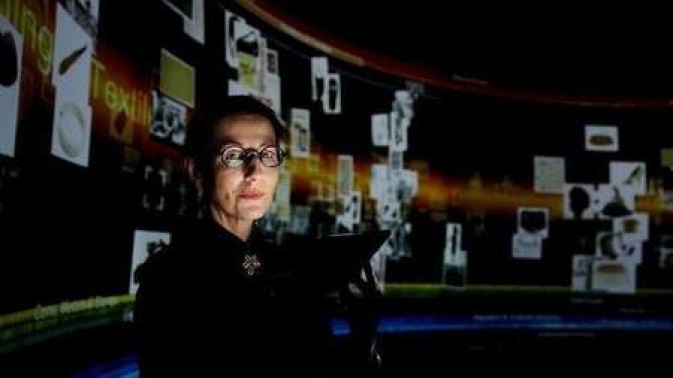Future of displays: Professor Sarah Kenderdine
says the new system is a technological and conceptual leap. Photo: Edwina Pickles
Sydney Morning Herald, September 18, 2014
Linda Morris
360 degree data-browser
Professor Sarah Kenderdine has developed an interactive digital browser for Museum Victoria allowing 80,000 previously unseen objects in the Museum's collection to be viewed by museum visitors. The data-browser is the first of its kind in the world.
Cutting edge technology has come to the rescue of Australia's hidden treasures, with an interactive cinema developed by the University of NSW to place on public display hundreds of thousands of photographs, cards and artifacts "lost" in museum collections.
With a mini tablet and 3-D glasses, visitors will be able to enter a giant cinema-in-the-round, dubbed the Tardis, to burrow through gallery and museum collections hardly seen by the public.
The physical effect is akin to standing in the centre of the shared virtual entity known in computing as the cloud, where networked information can be retrieved and visitors take themselves on a serendipitous journey of discovery through the network of linked information.
Future of displays: Professor Sarah Kenderdine says the new system is a technological and conceptual leap. Photo: Edwina Pickles
The digital browser was developed by the Museum Victoria and researchers at the UNSW iCinema Research Centre and is funded by the Australian Research Council. The design of the browser was led by Professor Sarah Kenderdine from the university's department of Art & Design and the museum's Tim Hart, and will be installed later this year.
Hailed by the university as the first of its kind in the world, this immersive cinematic experience has the potential to revolutionise traditional gallery going and museum practices.
At Museum Victoria where only a fraction of the collection is on display, museum visitors will be able to access the "storehouse and explore freely this wonderland of objects", says Professor Kenderdine. "It's like being in the Matrix!"
Professor Kenderdine says mARChive represents a technological and conceptual leap on the interactive microtile wall display installed in 2013 at the Cleveland Museum of Art which reproduces only 3000 images archived objects and was, until now, considered a model for future gallery displays.
The mARChive experience is one of immersion, movement, and a feeling of wonder as users explore and follow objects thematically and temporally. The connections between objects are made by description and metadata in the museum's collection management system, says Professor Kenderdine.
For the visitor, it conveys the sense of scale and amazement at the scope and size of large museum collections, usually for the first time, a realisation similar to the final scene of Raiders of the Lost Ark. The Ark of the Covenant is lost/stored in a warehouse and the camera pans over the enormous pile of like-sized wooden crates. mARChive allows visitors to open up the crates to reveal the treasures inside.
The browser is organised along eighteen themes from armour to leisure to natural science and Indigenous collections. This rich data is combined with an ever changing soundtrack made from the audio archives of the museum, among other sources.
While museums and galleries have been busy placing a sizeable portion of their collections on the internet, this is a genuinely immersive experience in which visitors are the drivers of their own experience and creators of their own narrative emerging from the collections, says Professor Kenderdine.
Museum Victoria's director of Public Engagement, Tim Hart, says the museum currently displays less than one per cent of its 17 million items acquired over 150 years.
Stored across three sites are significant collections of Australian indigenous cultural artifacts, an extensive natural science collection of animals, rocks, minerals and fossils and a collection unique to Victoria's historical and technological developments. It has the body of Phar Lap on display. The extent of the museum's collection was "mindboggling".
"This will enable visitors to make their own serendipitous journeys through the collections," says Mr Hart. "You know, it is a little like Alice in Wonderland going down the burrow, you find more and more as you drill down."
The next step, says Mr Hart, will see visitors complete brief survey forms to preorder information of interest, be it World War I or some other topic. "We will definitely be applying for more research funding."
The cylindrical 3-D projection screen is four meters high by 12metres wide, and features a 12 channel stereoscopic projection system and surround sound audio system.
It is one of nine interactive large screen display systems that have been built. Professor Kenderdine and Museum Victoria are in the early stages of developing a world travelling exhibition, Illuminating Asia, a virtual tour of Asian art and cultural heritage down the centuries using these nine displays. "It's a block buster which will tour major museums in China, Europe and North America. It will change the nature of museum-going experience forever."
